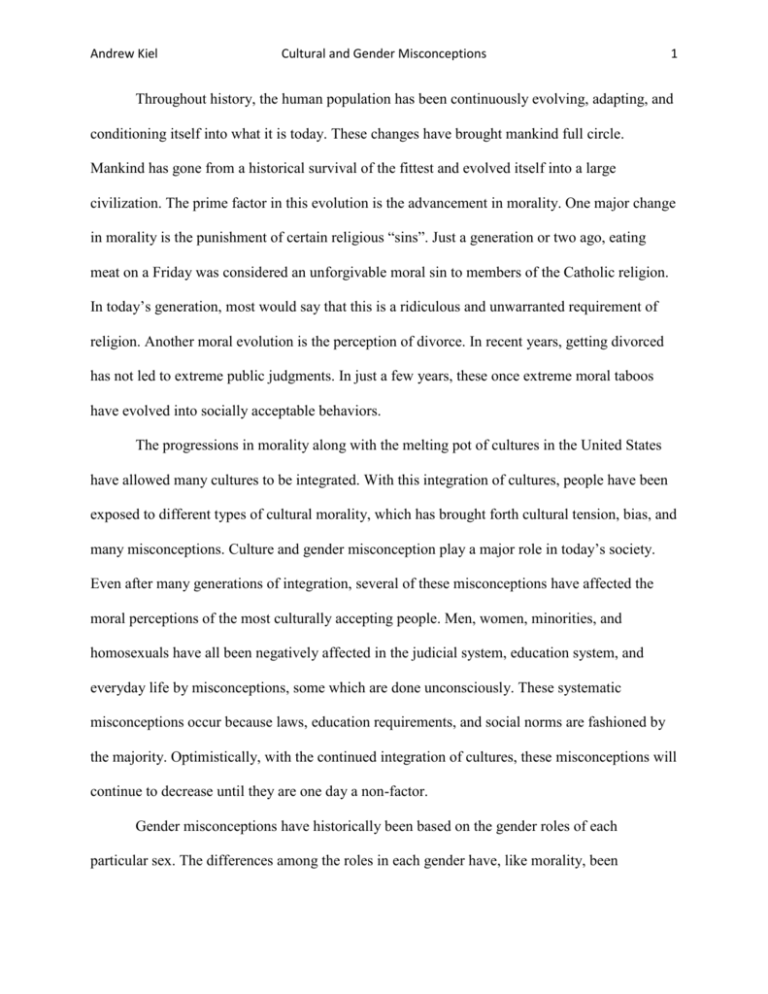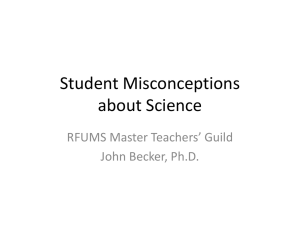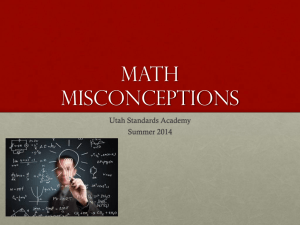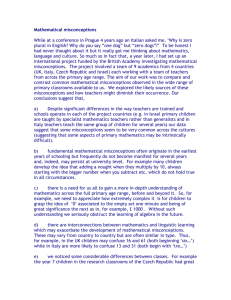
Andrew Kiel
Cultural and Gender Misconceptions
1
Throughout history, the human population has been continuously evolving, adapting, and
conditioning itself into what it is today. These changes have brought mankind full circle.
Mankind has gone from a historical survival of the fittest and evolved itself into a large
civilization. The prime factor in this evolution is the advancement in morality. One major change
in morality is the punishment of certain religious “sins”. Just a generation or two ago, eating
meat on a Friday was considered an unforgivable moral sin to members of the Catholic religion.
In today’s generation, most would say that this is a ridiculous and unwarranted requirement of
religion. Another moral evolution is the perception of divorce. In recent years, getting divorced
has not led to extreme public judgments. In just a few years, these once extreme moral taboos
have evolved into socially acceptable behaviors.
The progressions in morality along with the melting pot of cultures in the United States
have allowed many cultures to be integrated. With this integration of cultures, people have been
exposed to different types of cultural morality, which has brought forth cultural tension, bias, and
many misconceptions. Culture and gender misconception play a major role in today’s society.
Even after many generations of integration, several of these misconceptions have affected the
moral perceptions of the most culturally accepting people. Men, women, minorities, and
homosexuals have all been negatively affected in the judicial system, education system, and
everyday life by misconceptions, some which are done unconsciously. These systematic
misconceptions occur because laws, education requirements, and social norms are fashioned by
the majority. Optimistically, with the continued integration of cultures, these misconceptions will
continue to decrease until they are one day a non-factor.
Gender misconceptions have historically been based on the gender roles of each
particular sex. The differences among the roles in each gender have, like morality, been
Andrew Kiel
Cultural and Gender Misconceptions
2
evolving. One misconception that has not changed is the perception that men are more illtempered than women: “A general assumption in most cultures is that men are significantly more
aggressive than women, whereas women often are characterized by passive and communal
traits.”1 Other gender assumptions are that men, because they are more aggressive, often tend to
rush to conclusions and take a more forceful approach to accomplishing tasks, dealing with
confrontation, and performing everyday skills. Women, on the other hand, tend to think
rationally and take the proper time to make well-thought-out conclusions. These misconceptions
shape the way that men and women think about the opposite sex’s behavior.
In the judicial system, these misconceptions in gender are very noticeable and statistically
proven to make major impacts on the way each sex views certain court cases. In domestic
violence cases, the gender of the victim, perpetrator, and majority of the jury plays a significant
part in determining guilt, innocence, and punishments of these crimes. In terms of the victim, a
female victim from a male perpetrator in a domestic abuse case is “perceived more negatively”
than if the roles were switched.2 A male in domestic abuse cases, whether he is victim or
perpetrator, “will be viewed and charged more harshly than a corresponding female.”3 This
outcome in domestic abuse cases is directly related to gender roles.
In our society, the gender role of the male has traditionally been to be a protector of the
female sex. In the case of domestic violence, a male attacker is judged more harshly because he
is viewed as stronger and is attacking a weaker victim. When the female becomes the attacker,
the man is still viewed with less compassion because he is usually blamed for the specific
occurrence of the violence. A contributing factor to these outcomes may also stream from what is
1
Yourstone, Jenny, Torun Linholm, martin Grann, and Ola Svenson. "Evidence of Gender Bias in Legal Insanity
Evaluations: A case vignette study of clinicians, judges, and students." Department of Psychology: Stockholm
University (July 2007): 273-78.
2
Yourstone, Jenny, Torun Linholm, martin Grann, and Ola Svenson Pg. 273.
3
Yourstone, Jenny, Torun Linholm, martin Grann, and Ola Svenson Pg. 273.
Andrew Kiel
Cultural and Gender Misconceptions
3
called “in-group bias.” An in-group bias is defined as “the systematic tendency to favor one’s
own membership group.”4 The in-group bias only becomes a factor when the majority of the jury
is female.
Gender misconceptions are also apparent in the judicial system in determining whether or
not the perpetrator is legally insane. In insanity cases, “female defendants were overall one-anda-half times more likely to be deemed legally insane than their male counterparts.”5 Multiple
factors play parts in this statistic. The first factor could be related to personality traits;
“psychopathy is more strongly related to antisocial personality disorder for men than women,
whereas psychopathy in women is generally more strongly linked to borderline personality
disorder.”6 What this shows is that during the interview process of psychopathy, women’s
personality depicts their diagnosis. Another contributing factor is that the bases of most studies
done were historically performed by male physicians. The more male physicians represents the
unconscious in group bias that humans show. In a survey taken by Association of American
Medical Colleges’ Center for Workforce Studies, in 2008, “71.7 percent of physicians were
male.”7 Even in today’s society with women becoming more integrated in the work place, a male
dominance still is apparent in this particular profession.
Similar to gender misconceptions, cultural misconceptions also greatly affect individuals
in the governmental systems. Cultural misconceptions also are prevalent in our education and
medical systems. There are two main concerns of cultural misconception. The first is the cultural
bias of comprehensive testing: “In the case of multiple-choice tests, certain cultural groups may
4
Yourstone, Jenny, Torun Linholm, martin Grann, and Ola Svenson Pg. 274.
Yourstone, Jenny, Torun Linholm, martin Grann, and Ola Svenson Pg. 274.
6
Marion, Brandee E., and Martin Sellbom. "An Examination of Gender-Moderated Test Bias on the Levenson SelfReport Psychopathy Scale." Department of Psychology, University of Alabama (February 24, 2010): 235-43.
5
7
2008 Physician Specialty Data. Association of American Medical Colleges, Nov. 2008. Web. 2 Dec. 2012.
<https://www.aamc.org/download/47352/data/specialtydata.pdf>. (non-creditable)
Andrew Kiel
Cultural and Gender Misconceptions
4
interpret item stems or response options in ways that were not anticipated during test
development.”8 With the different interpretations, members of different cultures could be docked
points simply because they did not understand the question the way it was meant. The other
contributing factor to cultural misconceptions in the education system is the lack of diversity
among the teachers themselves. According to a survey done by the National Center of
Educational Information, eighty-five percent of all teachers in the United States are white.9 The
lack of diversity among teachers creates an automatic cultural bias towards the majority. The
cultural bias that is apparent in the education system also is a factor in the medical system. The
cultural misconceptions that happen often make minorities hesitant to even try action: “when
activated, implicit negative attitudes and stereotypes shape how medical professionals evaluate
and interact with minority group patients. This creates differential diagnosis and treatment,
makes minority group patients uncomfortable and discourages them from seeking or complying
with treatment.” 10 This misconception for minority cultures shines a very negative light on our
medical and educational systems.
The system that has the most cultural misconceptions is the judicial system. From police
officers to judges, the cultural misconceptions occur at every step. One common misconception
is DWB or Driving While Black. This streams from the harsh misconception that black people
are more likely to commit a crime. “African Americans in that city are 50 percent more likely to
be stopped than any other drivers… report that African American drivers were 17 percent more
likely than white drivers to be ticketed by the North Carolina Highway Patrol. These results
8
Banks, Kathleen. 2006. "A Comprehensive Framework for Evaluating Hypotheses About Cultural Bias in
Educational Testing." Applied Measurement In Education 19, no. 2: 115-132. PsycINFO, EBSCOhost (accessed
December 2, 2012).
9
Feistritzer, Emily. NATIONAL CENTER FOR. November2008. Accessed December 3, 2012.
http://www.edweek.org/media/pot2011final-blog.pdf. (non-creditable)
10
Stone, Jeff, and Gordon B Moskowitz. 2011. "Non‐conscious bias in medical decision making: What can be done
to reduce it?." Medical Education 45, no. 8: 768-776. PsycINFO, EBSCOhost (accessed December 3, 2012)
Andrew Kiel
Cultural and Gender Misconceptions
5
suggest that the degree of racial disparity can vary dramatically across jurisdictions.”11 In a
survey done by HOUSEHOLD DATA ANNUAL AVERAGES in 2011, only twelve percent of
police officers in the United States are African-American.12 This lack of diversity among police
officers can lead to an unconscious in-group bias shown by the police officers. Along with
DWB, racial misconceptions occur in the trail process as well. More often than not, the racial
diversity of the jury will determine the outcome of the trail. In a trail that has a very integrated
jury, the outcomes are far less likely to be influenced by race.
The factor of race is a result of the bringing forth of other cultural opinions and factors to
determine guilt or innocence: “when they are presumably less concerned about racism, White
jurors are harsher in their judgments of a Black than a White defendant”.13 Similar to most
process in life, when you expose one another to an alternative cultures thought process, you are
obligated to think more critically about a situation, rather than if just one culture was coming to a
conclusion on a topic. Unfortunately, there are some misconceptions that occur unconsciously
and judgments are passed. These unconscious judgments make it difficult to teach cultural
equality in occupations such as a police officer. “Hundreds of experiments have revealed that
stereotypes and prejudices influence the judgment and behavior of even egalitarian people
11
Warren, Patricia, Donald Tomaskovic-Devey, William Smith, Matthew Zingraff, and Marcinda Mason. 2006.
"Driving while Black: Bias processes and racial disparity in police stops." Criminology: An Interdisciplinary Journal
44, no. 3: 709-738. PsycINFO, EBSCOhost (accessed December 3, 2012).
12
Employed persons by detailed occupation, sex, race, and Hispanic or Latino ethnicity. HOUSEHOLD DATA
ANNUAL AVERAGES, Jan. 2011. Web. 3 Dec. 2012. <http://www.bls.gov/cps/cpsaat11.pdf>.
13
Sommers, Samuel R., and Phoebe C. Ellsworth. 2001. "White juror bias: An investigation of prejudice against
Black defendants in the American courtroom." Psychology, Public Policy, And Law 7, no. 1: 201-229. PsycINFO,
EBSCOhost (accessed December 3, 2012).
Andrew Kiel
Cultural and Gender Misconceptions
6
without their knowledge.”14 These unconscious misconceptions are relevant in every race and
judgment that occurs; no matter how culturally accepting an individual can be.
Another misconception is the judgments of homosexuals. Homosexual misconception
relates more to the gender misconception because they are mostly based of gender roles.
Homosexuality has been a highly debated and highly scrutinized throughout the written history
of the world. Historical figures such as Alexander the Great, King James of England, and Adolph
Hitler are just a few of many historical figures that are linked to homosexuality. Homosexuality,
like gender misconceptions, is based on the gender roles and gender expectations. As a man,
many believe that you are to have three main character traits that must define you, “status, which
reflects the belief that men must gain the respect of others, toughness, which reflects the belief
that men are physically tough and inclined to be aggressive, and anitfeminity, which reflects the
belief that men should avoid stereotypical feminine activates.”15 These gender roles make it very
difficult for some non-homosexual men to come to an understanding of gay men. Some might
say that there can be homosexual men that not only follow their gender roles, but also judge
others who do not.
A major judgment and misconception of homosexuality is that there are some religions,
cultures, and individuals that believe that homosexuality is an illness, or a choice rather than a
trait that a human is born with. These beliefs have been taken to far extremes to be proven, and
many of the treatment used is not only unethical, but harmful to the patients involved. One form
14
Stone, Jeff, and Gordon B Moskowitz. 2011. "Non‐conscious bias in medical decision making:
Parrott, Dominic J. "Aggression toward gay men as gender role enforcement: Effects of male role norms, sexual
prejudice, and masculine gender role stress." Journal Of Personality 77, no. 4 (August 2009): 1137-1166. PsycINFO,
EBSCOhost (accessed December 3, 2012
15
Andrew Kiel
Cultural and Gender Misconceptions
7
of treatment that was used was Aversion Therapy.16 Aversion therapy simply places a positive
feeling with a negative consequence; “aversion therapies pair an unpleasant event with some
form of undesirable behavior.” One form of Aversion Therapy is shock therapy. This was done
by showing homosexual men pictures that were intended to arouse them. Once aroused, these
men would receive an intense shock. These were done to condition gay men to be scared when
thinking of homosexual thoughts.17 The results of some of these experiments brought long term
depression and also caused the struggle to have a true identity.
Another form of treatment is Sexual Orientation Conversion Therapy. These treatments
came from the idea that homosexuality was and could be “cured”. “These treatments were who
advocate intensive, long-term therapy aimed at resolving the unconscious anxiety stemming from
childhood conflicts that supposedly cause homosexuality.”18 This therapy even went as far to
create a Homosexual Anonymous which is a four-teen step program that similar to Alcohol
Anonymous.19 Most of the treatments that have been developed to cure homosexuality have not
worked in the long run. These treatments not only fail, they often cause serious mental health
issues for the patients that are involved because their homosexual desires remained.
Unfortunately there are still organizations and religious groups that discriminate on homosexuals
and the misconceptions are shown in everyday life.
In relation to moral theories, cultural and gender misconceptions are highly immoral
based on virtue ethics and deontology. “Virtue Ethics requires looking at a person’s behavior
16
Callahan, Edward J., and Harold Leitenberg. 1973. "Aversion therapy for sexual deviation: Contingent shock and
covert sensitization." Journal Of Abnormal Psychology 81, no. 1: 60-73. PsycINFO, EBSCOhost (accessed December
3, 2012).
17
Callahan, Edward J., and Harold Leitenberg. 1973. "Aversion therapy for sexual deviation: Pg. 61.
Callahan, Edward J., and Harold Leitenberg. 1973 pg. 227
19
Callahan, Edward J., and Harold Leitenberg. 1973 pg. 224
18
Andrew Kiel
Cultural and Gender Misconceptions
8
from the ‘inside’ as well as the ‘outside’”.20 What this definition of Virtue Ethics says, is to put
yourself in their shoes. In the case of gender and cultural misconceptions, it is clear that people
tend to do the opposite. Even though at certain times these misconceptions are brought about
unconsciously, the overall single-minded thinking would not be moral. When it comes to the
misconception in a jury trial, juries of the opposite race or culture as the defendant, must be able
to view the cultural differences and be exposed to what the defendant might be thinking based of
those cultural differences. Without the ability to think outside the box, these misconceptions will
continue to happen in our judicial, educational, and medical systems.
Similar to Virtue Ethics, Deontology would consider these misconceptions to be immoral
behavior. Deontology “is the way of think about ethics focuses on the nature of the action itself
rather than on the consequences that follow from the action.”21 Deontology is also a sense of
duty, and fairness according to Kyte. Relating Deontology to the gender and cultural
misconceptions, one can conclude that these actions do not meet the requirements of moral
behavior. In order for Deontology to be relevant, individuals must begin to figure out ways to
relate to members that our not in one’s group. Until this day comes, any misconception that is
passed from one individual to another will not be considered moral in relation to Deontology.
Although it seems clear that cultural and gender misconceptions stream from lack of
diversity in many occupations, contradicting opinions may view these misconceptions from a
different outlook. Some might say that these cultural misconceptions in the research and
experiments that are done are completed to be beneficial to the greatest good of the population.
The argument that doctors, police officers, lawyers, teachers, and other professionals with civic
duties, are doing what they can to make sure that all citizens no matter race, gender, or sexual
20
21
Kyte, Richard. An Ethical Life. Winona, MN: Christian Brothers Publication, 2012. Pg. 171.
Kyte, Richard. An Ethical Life. Winona, MN: Christian Brothers Publication, 2012. Pg. 137.
Andrew Kiel
Cultural and Gender Misconceptions
9
orientation have an equal chance at opportunity. Another counter argument might be that with
integration, racial and gender misconceptions are just excuses people use for being found guilty,
pulled over, or social outcast. People might believe that racism is no longer an issue and that all
minorities have the same equal treatment of the majority.
My personal views on these misconceptions are that they, for the most part, are not going
anywhere. Although I feel that these misconceptions are becoming less of a factor, I do believe
that they will exist forever. Even though I feel they will always be relevant, cultural and gender
misconception may not always be negative. Having differences in cultures allows the human
population to grow as a society and brings more knowledge and understanding to us. With my
experience at the Boys & Girls Club, I am able to witness first hand racism or lack thereof
between whites and various minority groups at the next generation. As we evolve, each
generation bridges another gap in becoming a more integrated society. With the full integration
of black culture in the media, children of the next generation are exposed to this culture and are
able to view these cultures without discrimination. Ultimately, these cultural changes are
becoming similar to the cultures changes among the white race. Cultural differences among
white Americans have evolved itself. For example, the Irish settlers faced extreme amounts of
discrimination at first and now St. Patrick’s Day is a highly celebrated holiday in the United
States. Eventually, I think that these same things will happen between whites and people of
other race and culture.
As mankind continues to evolve, morality will as well. Although many misconceptions
for gender, culture, and sexual orientation will still be perceived, mankind will continue to grow.
One day, the judicial system may no longer witness cultural and gender bias over ones on social
group, minorities might not have to worry about getting pulled over because of their skin color,
Andrew Kiel
Cultural and Gender Misconceptions
10
and homosexuals perhaps will not have face scrutiny based of gender roles in which they might
struggle to fulfill. It is unfortunate that the human population has yet to reach the point of
equality and understanding. However, the famous saying of “you got to start somewhere” fits
greatly in the conversation of cultural understanding. If no one was willing to start the
integration, we would not be as advanced in understanding as we are today. Hopefully, very
soon, all people will be able to recognize and accept cultural, gender, and sexual differences; and
realize that these differences do not make any group better or worse.
Andrew Kiel
Cultural and Gender Misconceptions
11
Works Cited
2008 Physician Specialty Data. Association of American Medical Colleges, Nov. 2008. Web. 2
Dec. 2012. <https://www.aamc.org/download/47352/data/specialtydata.pdf>. (noncreditable)
Banks, Kathleen. 2006. "A Comprehensive Framework for Evaluating Hypotheses About
Cultural Bias in Educational Testing." Applied Measurement In Education 19, no. 2: 115132. PsycINFO, EBSCOhost (accessed December 2, 2012).
Callahan, Edward J., and Harold Leitenberg. 1973. "Aversion therapy for sexual deviation:
Contingent shock and covert sensitization." Journal Of Abnormal Psychology 81, no. 1: 6073. PsycINFO, EBSCOhost (accessed December 3, 2012).
Employed persons by detailed occupation, sex, race, and Hispanic or Latino ethnicity.
HOUSEHOLD DATA ANNUAL AVERAGES, Jan. 2011. Web. 3 Dec. 2012.
<http://www.bls.gov/cps/cpsaat11.pdf>. (non-creditable)
Feistritzer, Emily. NATIONAL CENTER FOR. November2008. Accessed December 3, 2012.
http://www.edweek.org/media/pot2011final-blog.pdf. (non-creditable)
Kyte, Richard. An Ethical Life. Winona, MN: Christian Brothers Publication, 2012. Pg. 137.
Marion, Brandee E., and Martin Sellbom. "An Examination of Gender-Moderated Test Bias on
the Levenson Self-Report Psychopathy Scale." Department of Psychology, University of
Alabama (February 24, 2010): 235-43.
Parrott, Dominic J. "Aggression toward gay men as gender role enforcement: Effects of male
role norms, sexual prejudice, and masculine gender role stress." Journal Of Personality 77,
no. 4 (August 2009): 1137-1166. PsycINFO, EBSCOhost (accessed December 3, 2012
Andrew Kiel
Cultural and Gender Misconceptions
12
Sommers, Samuel R., and Phoebe C. Ellsworth. 2001. "White juror bias: An investigation of
prejudice against Black defendants in the American courtroom." Psychology, Public Policy,
And Law 7, no. 1: 201-229. PsycINFO, EBSCOhost (accessed December 3, 2012).
Stone, Jeff, and Gordon B Moskowitz. 2011. "Non‐conscious bias in medical decision making:
What can be done to reduce it?." Medical Education 45, no. 8: 768-776. PsycINFO,
EBSCOhost (accessed December 3, 2012)
Warren, Patricia, Donald Tomaskovic-Devey, William Smith, Matthew Zingraff, and Marcinda
Mason. 2006. "Driving while Black: Bias processes and racial disparity in police stops."
Criminology: An Interdisciplinary Journal 44, no. 3: 709-738. PsycINFO, EBSCOhost
(accessed December 3, 2012).
Yourstone, Jenny, Torun Linholm, martin Grann, and Ola Svenson. "Evidence of Gender Bias in
Legal Insanity Evaluations: A case vignette study of clinicians, judges, and students."
Department of Psychology: Stockholm University (July 2007): 273-78.










